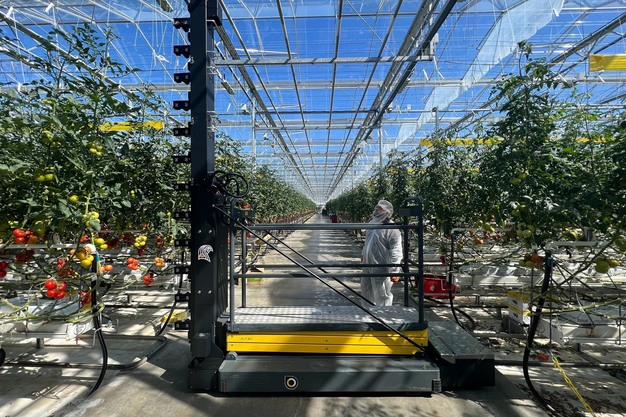Carrying out plant measurements in a greenhouse can be quite a daunting task. After all, the conclusions drawn from these measurements form the basis of future cultivation decisions. "Plant measurement is a common task in a greenhouse," says Roberto Ramirez, vice president of greenhouse operations at Bushel Boy Farms, headquartered in Owatonna, Minn. with an additional campus in Mason City, Iowa. "It's always a bit of a struggle and it's quite the time sink."

Measuring plants in the greenhouse
For those who don't know, collecting plant measurements (often known as crop registration) involves walking around the greenhouse at specific times of the day to measure variables, such as height, stem width, or spotting abnormalities, on a sample size of, say, ten plants. However, there's a flaw to this methodology. "We have always questioned how representative of the whole cultivation that sample is. For instance, you do plant measurements at a different time than the previous one, and some data points can be altered because of that. Also, a worker may have broken the head of a plant, or the plant in question outright died, meaning that you've lost other data points," Roberto points out.

That pitfall is also very much connected to another horticulture industry challenge, namely labor shortage. "Labor is scarce, and talented labor is even scarcer," he continues. Finding the right team and training them in routine greenhouse tasks takes up quite a chunk of time, which could be focused on plant steering strategy. Eventually, one has to succumb to the constraints, and chances of human error increase exponentially. When many inefficiencies pile up, a company's bottom line can be severely affected. The Bushel Boy Farms team realized that something had to change. That change came in the form of AI. "We enjoy exploring new tech," says Chuck Tryon, president of Bushel Boy Farms. "But a new tech without a group of people behind it is just a shiny gimmicky toy. That's when IUNU came into play."
 Roberto Ramirez, VP of greenhouse operations & Chuck Tryon, President of Bushel Boy Farms
Roberto Ramirez, VP of greenhouse operations & Chuck Tryon, President of Bushel Boy Farms
Looking through the AI glass
IUNU, a pioneer in agriculture technology, developed LUNA AI, which uses computer vision to track and analyze plants in the greenhouse and support growers in their daily decision-making. To start developing on the technology, Chuck and his team sat in his office together with Adam Greenberg, co-founder and CEO of IUNU, with a whiteboard, and a bunch of markers. "Adam was able to see what our challenges were and what our priorities should be," Chuck recounts. "Our collaboration with IUNU started with a really deep understanding on what we were looking for and what we needed." This is the spirit that carried through their partnership. "We went from measuring about 10 plants to measuring thousands of plants," Roberto remarks. "We are measuring every day now, and we are constantly getting living data, rather than outdated."
But how does LUNA AI actually work? "There are a couple of important things to consider," Adam explains. "First, labor quality and management, and how you track them. Labor is the biggest cost in a greenhouse, and there is variability in worker performance. The concept of labor quality is very subjective, until now. With LUNA AI, we focus on automating labor-intensive activities like crop registration to establish consistency and remove the need for growers to have to collect measurements manually."
To achieve this, IUNU created a model capable of recognizing patterns within images. They transformed 3D pixel imagery into numerical data that the AI could understand. "Every single pixel has a value and can understand its relationship with nearby pixels in 3D space and over time," Adam points out. "This allows LUNA AI to continuously monitor the plants in the greenhouse and automatically detect any changes."
Creating this model was complex, involving consideration of numerous variables. "The biggest problem is that many solutions simply gather sensor data, apply AI, and call it autonomous growing," Adam notes. "However, this approach often results in outdated data. With traditional crop registration, scouting teams collect data at specific times, often only once a week, making it obsolete by the time it's used. Growing plants isn't like manufacturing food products, where you follow recipes and only rely on a simple, repeatable process. Growing plants requires a repeatable process along with continuous assessment and adjustment. Growers must monitor plants continuously and make real-time, informed decisions based on daily plant data, not weekly. That's what LUNA AI enables."

Preventing and reacting
Since LUNA AI was installed at Bushel Boy Farms, Roberto has had better control over the cultivation, and the results show. "Thanks to the data provided by LUNA AI, we can act earlier, and by acting earlier we are correcting mistakes faster, or we are outright preventing them. LUNA AI alerts you that things are not normal, such as a leaf that looks abnormal. The AI would detect the distance between each plant top, it'd tell you if lowering has been done all right, and also why there's so much difference between the head heights in those rows. That would tell me, for instance, that the greenhouse technician that is doing the lowering is not taking care of the plants equally." You can tell that Roberto is quite concerned about crop uniformity, and the issue with different plant heights and tops must have given him quite some headaches. "The AI is basically telling me that we are spending more money on labor in the greenhouse because a specific task wasn't done properly, and now we can see that right away as metrics may tell us that a crop is growing way faster or slower than it should." Having an overview not only of how plants perform but also of how labor is distributed in the facility helps bridge the gap between growers on-site and the upper management. "So, they know why certain things happen in the greenhouse without me telling them," chuckles Roberto.
But all jokes aside, that's a crucial aspect for people like Chuck as it allows Bushel Boy Farms to be a better supplier. "The overarching opportunity for us is to be producing more products of a higher quality," he says. "On top of that, we now have a good line of sight on how much product we have and when it will be ready. This allows us to tighten the value chain, so we can be a better supplier."
 Adam Greenberg, co-founder and CEO of IUNU
Adam Greenberg, co-founder and CEO of IUNU
Cultivation knowledge as intellectual property
Since LUNA AI automates many manual processes and provides visibility of greenhouse performance, Bushel Boy Farms is now capable of building up institutional knowledge and turning that into intellectual property. "In essence, growers around the world are filled with knowledge in their head. LUNA AI is allowing us to capture that value, and we now have the ability to take that institutional knowledge and turn it into IP, providing us even more additional value. In other words, LUNA AI has made us understand that the experience we have in growing certain varieties is something we can leverage to protect our own interests. This tech has just started opening that door."
Now that Bushel Boy Farms has joined the AI fray, they can stretch more and are considering more crops. "The products we have added in the last 3-4 years have been very well accepted by our partners and consumers. With LUNA AI, we are going to continue to do that even better."
For more information:
IUNU
[email protected]
iunu.com
For more information:
Bushel Boy Farms
www.bushelboy.com
